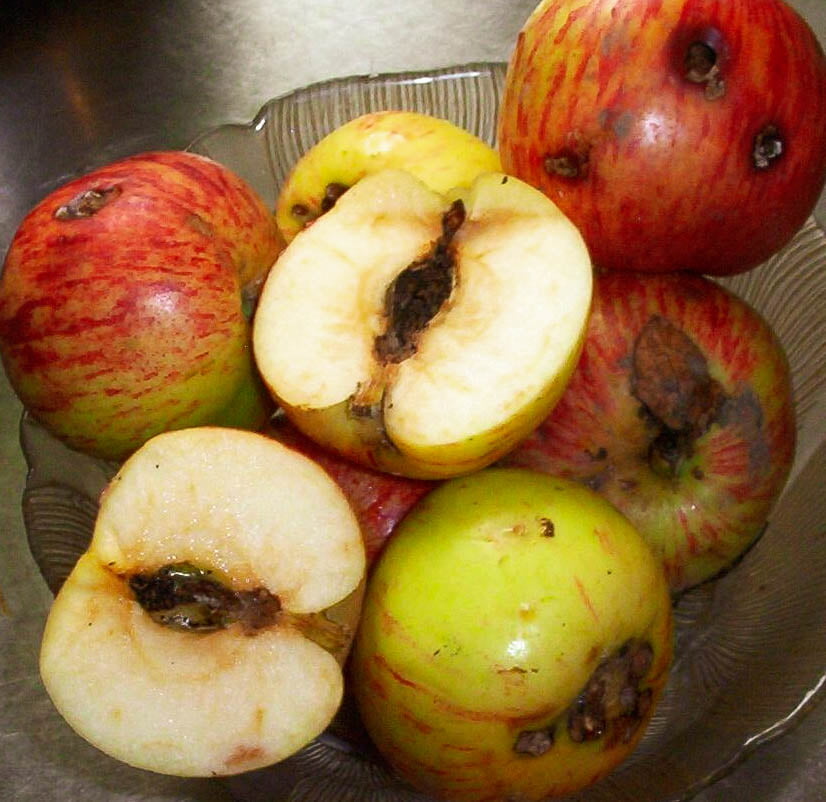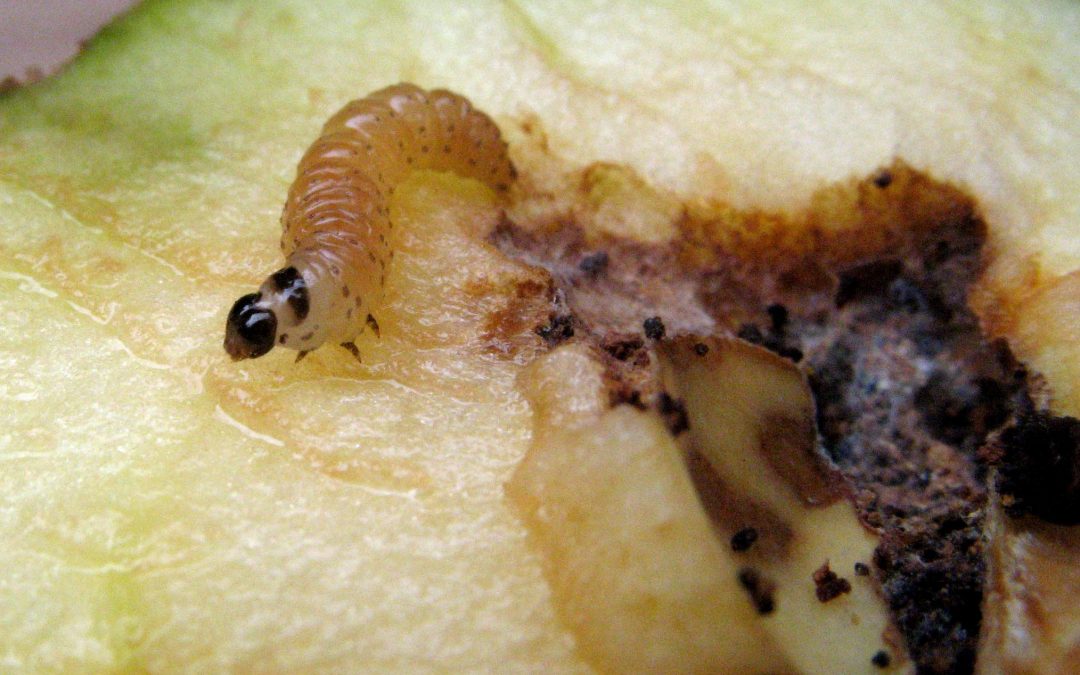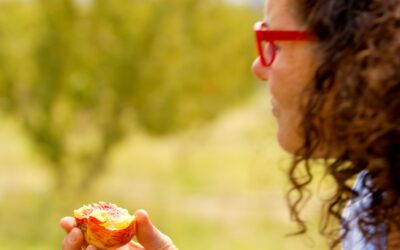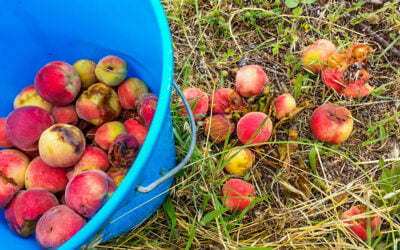Estimated reading time: 3 minutes
Grubs in apples are scary and revolting – particularly if you only find half a grub, right?
There’s the visceral disgust of biting into an apple and finding that something is living inside. But it also downgrades the quality of the fruit.
Related Articles
How to make and use a fruit picking diary
Using a fruit-picking diary can help solve the problem of choosing the exact time to pick your fruit so it’s neither under-ripe nor over-ripe.
Why you should pick up fruit from the ground
Picking up your fruit from the ground is the first principle of organic orchard hygiene, and one of your best lines of defence against pests.
Netting fruit trees made simple for backyard growers
The sooner you net your fruit trees, the sooner you’ll get reliable crops. We explain the different systems to help you choose the right one.
Apples that have been infected with Codling moth are much less usable, and less valuable for all these reasons:
- the apples go bad quickly;
- infected apples aren’t suitable for long term storage;
- they’re more likely to be attacked by diseases (e.g. rots) and even other pests;
- they can’t be sold commercially if infected;
- they look bad so you don’t want to share them friends and family;
- having to cut the affected part out before cooking or eating is very wasteful.

If the grubs have left the apple this can be even worse, as it tells you that the grubs were able to complete their life cycle and go on to breed again, perpetuating your Codling moth problem and increasing their population.
Codling moth action plan
Codling moth is one of the more challenging pests that fruit growers have to deal with. But don’t despair, there is a way!
Here’s our 6-step plan for preventing and managing them:
- First, find out whether Codling moth are a problem in your area. If you already have them in your apples, this one’s a no-brainer, but if you’re new to fruit growing you may need to ask around other fruit growers in your area to find out if it’s something you need to be prepared for.
- Learn how to identify them. This is where the Grow Great Fruit program can come in very handy.
- Understand their life cycle. Good organic pest management depends on knowing your enemy. Every pest (and every disease for that matter) has at least one weak point in their life-cycle when it’s easy (or at least possible) to intervene. The aim is to interrupt their life cycle. You want to reduce the size of the population, and to reduce or prevent the damage they do. Over time you’ll hopefully eradicate the problem. We run a free workshop to explain this principle in more detail.
- Familiarise yourself with the many tools you can use against Codling moth – including trapping, banding, pheromone ties, chickens, predator insects, pruning, etc.
- Decide which one will work best for you, and write your own Codling moth plan.
- Conquer the Codling moth!

These steps are covered in more detail in the Conquer Codling Moth short course, which also includes a step-by-step process for writing your own plan.
If you already have Codling moth in your apples and are not taking active steps to control them, they’re likely to get worse. Because they complete most of their life cycle inside the apple or hidden in the soil or the bark, they’re not easy for predators to find.
Unless you intervene to stack the odds against them, in un-managed apple trees the problem tends to grow, so ignore them at your peril!
Related Articles
How to make and use a fruit picking diary
Using a fruit-picking diary can help solve the problem of choosing the exact time to pick your fruit so it’s neither under-ripe nor over-ripe.
Why you should pick up fruit from the ground
Picking up your fruit from the ground is the first principle of organic orchard hygiene, and one of your best lines of defence against pests.
Netting fruit trees made simple for backyard growers
The sooner you net your fruit trees, the sooner you’ll get reliable crops. We explain the different systems to help you choose the right one.







We layered cardboard beneath each tree with straw on top and painted the trunks with Hydrated Lime. Should we remove the cardboard now to check for larvae?
Hi Julie, now would be a good time to check for larvae as they will be getting ready to emerge soon.
Hi Hugh, I have an apple tree which has Codling moth. As I was not here in Tasmania until July this year, I did not take the precautions. Is it too late for me to do anything now?
Thank you, Krishnee Hennessy
Hi Krishnee, it’s not too late – definitely worth adding a cardboard/hessian band and working on suppression mulching right away might help! And then monitor your tree for the signs throughout these warmer months.
Good luck, Meg – Grow Great Fruit team.
Hi I tried cardboards bands on my trees and they didn’t seem to work. I got frustrated and left them. Is it too late to do something to save any fruit? Thanks
It’s not too late (unless you’re in the northern hemisphere and already have fruit?) Did you try the cardboard bands last season? Depending on the time of year, there are still lots of things you can do throughout the year to reduce populations, e.g. allowing chickens to have a good peck under the trees as the moths emerge from the pupae in spring is a great one. And, the cardboard or hessian bands do usually need to be dealt with every few weeks, so perhaps increasing the frequency that you replace them next time? They’re mainly useful to create pupation sites for the larvae throughout the season, and they can make a big difference! Good luck, Meg – Grow Great Fruit team.
We moved to a new house last year. The old apple tree (not sure what type) had lots of almost pear-shaped fruit which had dry, sour tasting flesh. My husband pruned the tree in the autumn and this year we have masses of shiny/rosy fruit. UNFORTUNATELY the fruit is falling off the tree with either a small hole bitten in the flesh with a rotten centre or it falls from the tree already half rotten. We are really disappointed. There is a plum tree about 20 yards away and it too had this problem last year. ( mildew on the skin and moth within.) It was heavily pruned and only had a single fruit on it this year-which went rotten, even though we treated the surrounding soil with Jeyes fluid several times I am wondering if the moths have come to the apple tree because I planted a mass of daffodil bulbs under it’s spread. These put on a great show but I am prepared to dig them up if it means we get a good harvest of apples. Please advise. Many thanks. Linda.
Hi Linda, not quite sure what Jeyes fluid is in this instance – can you explain that treatment? And, it’s unlikely that the daffodils would be making the problems too much worse, especially if you follow some of the steps we outline in the blog above. In the fruit that was damaged, did you actually identify what was causing the problem (e.g. have you seen a coddling moth larvae?). Or, could there be something else going on? Best of luck, Meg – GGF team.